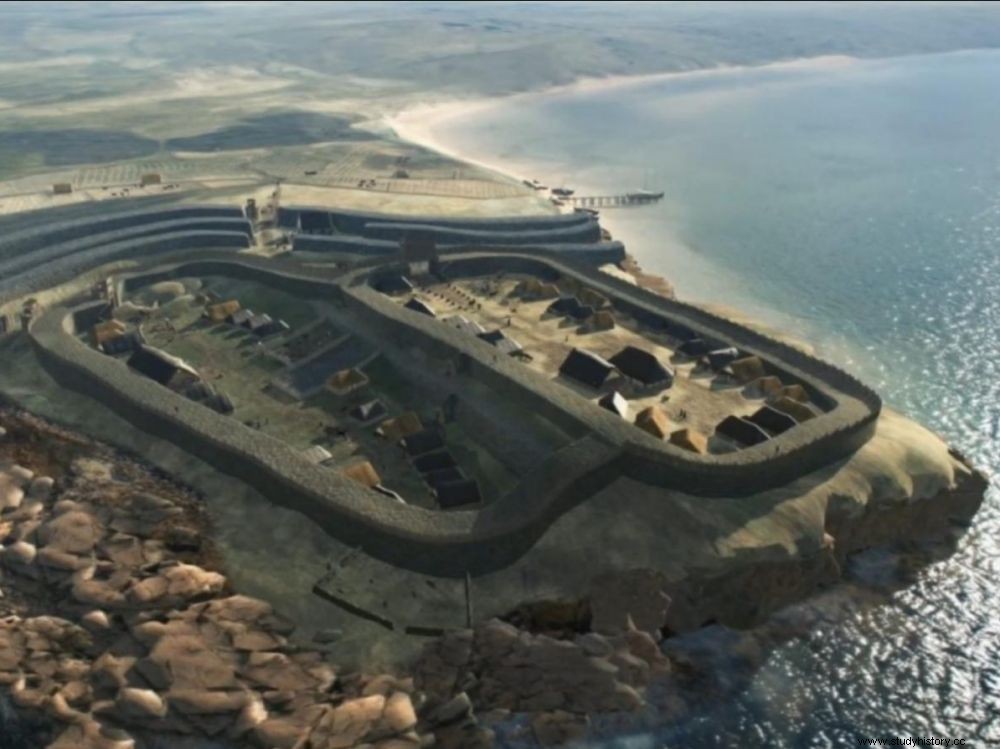Of the Picts, warlike tribes of northern Scotland who never bent their knees to the Romans, there are only a few remains to this day. But Burghead Fort, the largest Pictish complex known to date, has just been the subject of a 3D reconstruction that sheds new light on the story of these so-called barbarians.

A digital reconstruction of the fort of Burghead, a village in the north of Scotland.
Considered obscure and mysterious, the Picts have nevertheless been abundantly described in literature from the beginning of the Middle Ages. In his Ecclesiastical History of the English People, Bede the Venerable, an Anglo-Saxon monk considered the "father of English history", explains in particular that the Picts were an amalgam of tribes who occupied the north of present-day Scotland between the 3rd and 10th centuries. Diehard warriors, the Picts made a lasting impression on the minds of the Romans. And for good reason:they never managed to submit to the Empire despite the latter's multiple military attempts.
The most important Pictish vestige
Their name, from the Latin "picti " - which literally means "painted men" - comes from the fact that they would have fought half-naked, covered with multicolored patterns all over their bodies. The Venerable Bede also reports that the Picts educated young girls in the art of war , some finishing in the same rank as their male counterparts. From an early age, they are said to have learned to wield sword and shield, sometimes even rising to the rank of chieftains of clans. The Picts also left magnificent engraved stelae, scattered throughout Scotland.
Few Pictish vestiges remain, but some high places of their history have come down to us. Among them is Burghead Fort in Moray, which is now believed to be the largest known Pictish remnant. Excavated by the University of Aberdeen since 2015, it is now the subject of a fascinating three-dimensional reconstruction, giving a glimpse of what it might have looked like more than a thousand years ago. Funded by state-owned Historic Environment Scotland as part of a wider video project aimed at enabling the public to learn more about Scotland's Pictish past, the footage shows the massive defensive ramparts, which are thought to be they were eight meters thick and six meters high, together with the dwellings inside the fort.
Testimonies of daily life
While historians and archaeologists have long known that Burghead was once home to a Pictish settlement, it was widely believed that the great urban works of the 19th century erased most traces of this important period in Scottish history. Indeed, almost a century and a half ago, the ramparts on the land side were leveled and part of the sea side defenses were destroyed for the construction of the modern port of the city. During this vast project, more than 30 Pictish sculpted stones were discovered, but only six - sculpted bulls - were preserved, as well as a number of fragments of early Christian sculpture. That's why scientists at the University of Aberdeen expected little to emerge from the site.
They were wrong. Over the past six years, excavations have been surprisingly successful, yielding some of the best-preserved remains of habitation (floors, hearth) and objects of Pictish daily life ever unearthed. The fort appears to have been destroyed in the 10th century, a period corresponding to the decline, in the face of the Vikings, of the Gaelic kingdom of Dál Riata into which the Picts had merged.
